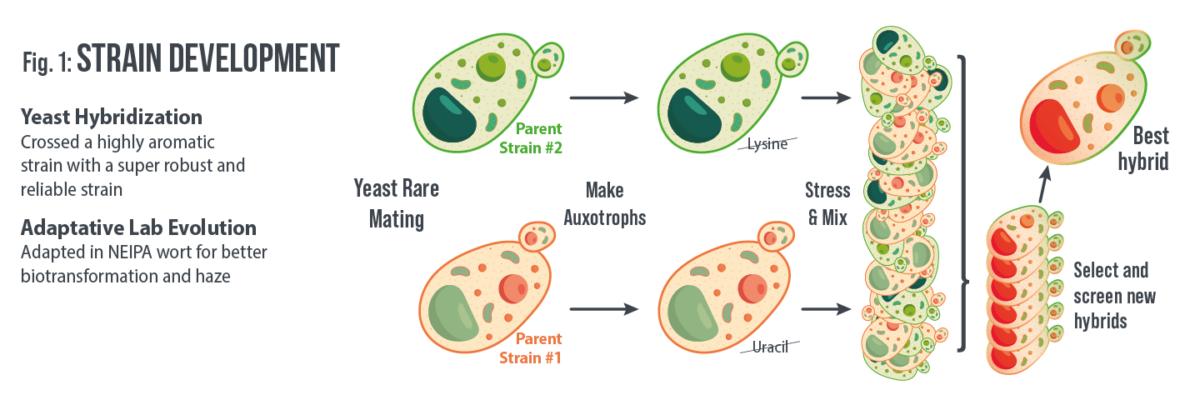Blog | Reading Time 3 minutes
Brewers’ Feedback for LalBrew Pomona™
Designed specifically for modern IPA styles, this novel hybrid yeast puts a unique spin on a range of hoppy beer styles. Since LalBrew Pomona™ was launched in summer 2024, it has quickly become a mainstay in the toolbox of IPA brewers. The story of LalBrew Pomona™ started at Escarpment Labs (Canada) with the goal to create the yeast the market needs for brewing modern hop-forward beers, with robust and consistent fermentation, intense fruit aromas, and high biotransformation potential.
What makes LalBrew Pomona™ different?
The characteristics of this strain are the result of a two-step selection process in the lab. First, Yeast Hybridization (breeding) was used to create a new yeast strain with unique characteristics. The first parental strain was selected for its unique and intense aroma as well as its biotransformation potential. The second parent was selected for high stress tolerance, high attenuation, and robust and consistent fermentation performance. Second, the new hybrid strain underwent Adaptive Lab Evolution by repeated propagation in highly hopped, high ABV fermentations. This process improved stress tolerance genetic stability, repitchability, and biotransformation potential. (Fig. 1)

Hazies with a West Coast twist
In terms of attenuation, LalBrew Pomona™ falls somewhere between East Coast and West Coast. An intense haze and punchy fruit character gives a look and aroma profile of a hazy NEIPA, but the finish is cleaner, dryer, and more in line with West Coast IPAs. Depending on your malt bill and mash, attenuation can run anywhere from 75-84%. Nova Runda Brewery (Croatia) noted that since LalBrew Pomona™ ferments dryer than comparable yeasts, and it may be well-suited to Double NEIPA and other high ABV styles.
Unique flavors through biotransformation
Trials show the biotransformation potential of LalBrew Pomona™ is exceptional, and the flavor potential is seemingly limitless by varying the hop variety and addition point. Early dry hopping with high free/bound geraniol hops can increase the amount of citronellol in the beer. Late dry hopping with tropical hop varieties complements the unique ester profile of this yeast for a fruit punch character that is crisp and refreshing.
We have seen nuanced expression of mango, lemongrass, and starfruit using this strain, while others have described notes of tangerine and pineapple. Our initial lab results have shown good terpene biotransformation potential for LalBrew Pomona™ and brewers are also reporting excellent potential for thiol biotransformation.
Sierra Nevada Brewing Co. (USA) pointed out that when compared to LalBrew Verdant IPA™, “the aroma expression from LalBrew Pomona™ was much higher in passionfruit, guava, and other thiol compounds with undertones of citrus.” In the Lallemand Brewing R&D Lab, we are beginning to unravel the unique nature of its flavor profile.
What about haze?
No IPA yeast assessment would be complete without a discussion of haze. Commercial trials have shown that LalBrew Pomona™ produces a consistent and stable haze. Humalakoda Brewery (Estonia) was pleasantly surprised by the haze formation and stability since they often struggle with haze retention in the finished beer. Note the haze produced can be removed if desired by centrifuge, filtration, or finings. This strain will also flocculate well for easy harvesting and re-pitching. Of the 28 commercial trial partners, 93% would consider using LalBrew Pomona™ again in the future, with key selling points being haze, suitability for hoppy styles, flavor profile, and fermentation speed and attenuation. ÅBEN Brewery (Denmark) sums it up well: “LalBrew Pomona™ performs like LalBrew Nottingham™ but with the haze stability of LalBrew Verdant IPA™ and a prominent and enjoyable ester profile. It takes off like a rocket and performs much better than other IPA strains. As soon as the yeast came in contact with hops, it brought out apricot/ripe peach and guava aromas, with a touch of passionfruit and orange/grapefruit citrus for brightness.”
Published Jan 1, 2025 | Updated Feb 5, 2025